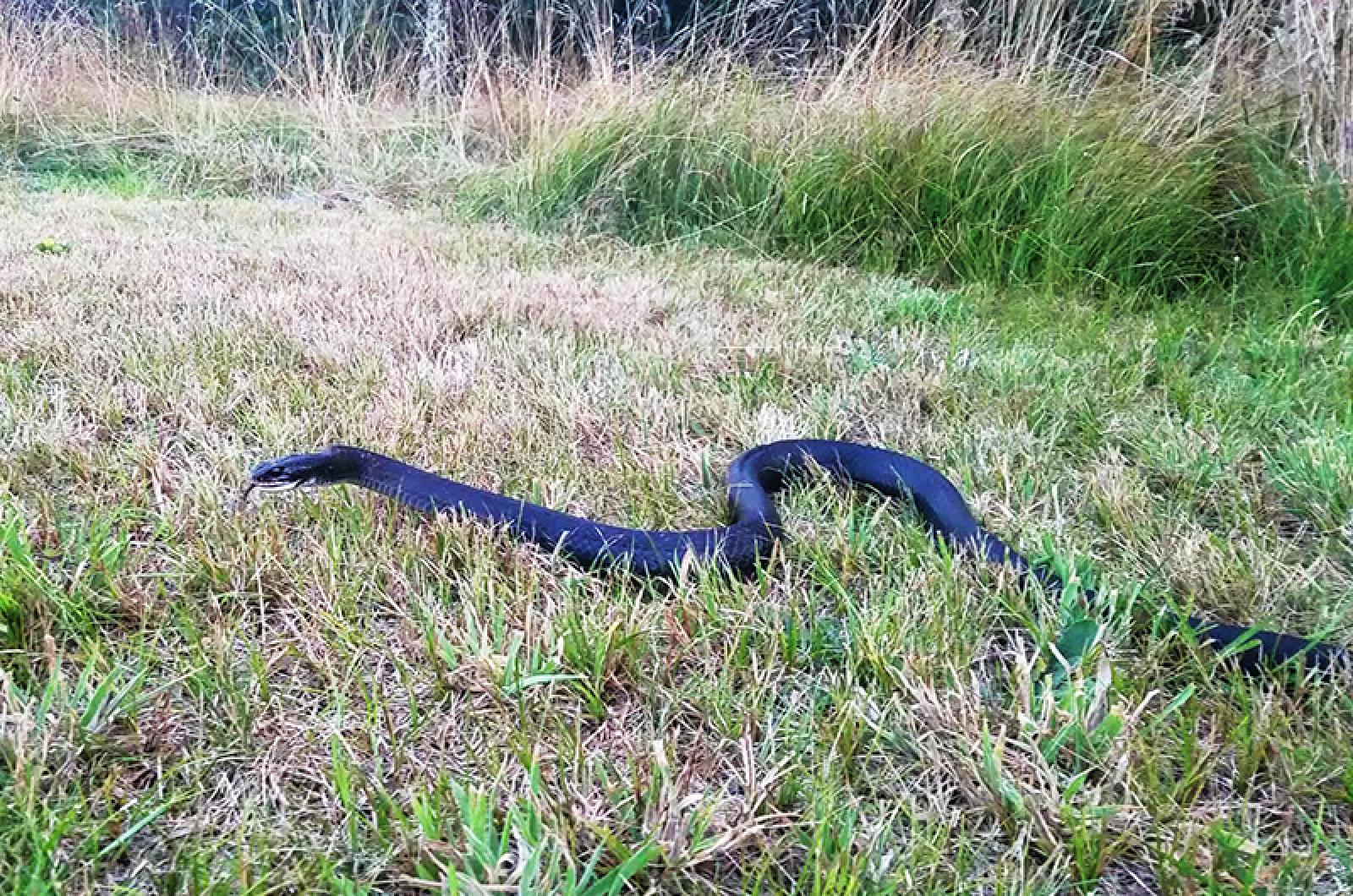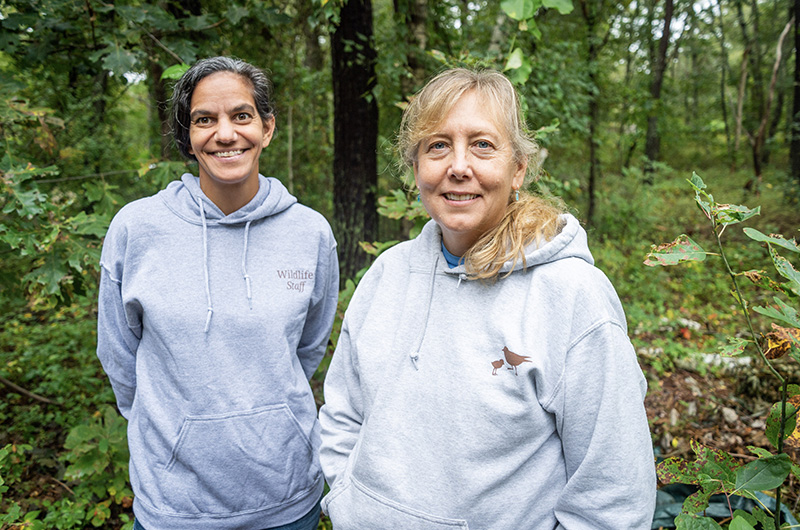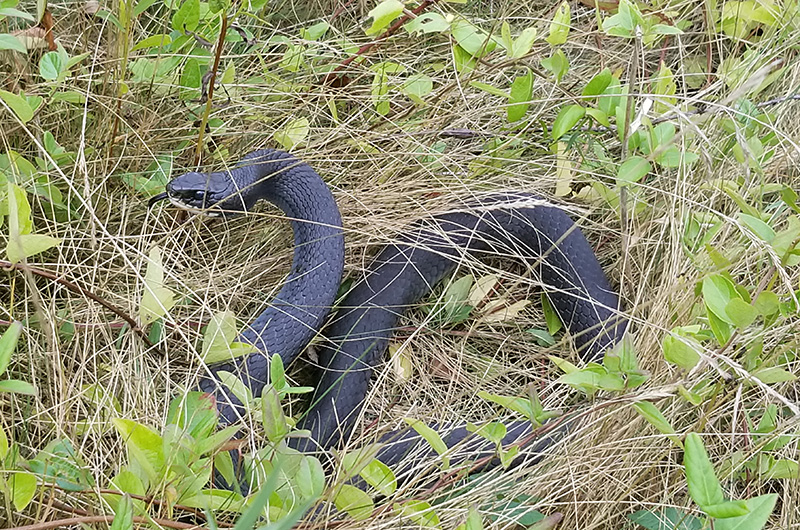Of the eight snake species on Island, none are venomous. But one is very large, and it is in danger.
The black racer snake can grow to over five feet long, but even at that length they mostly move about unseen — from the plains of Katama to the low lying woods along Moshup Trail in Aquinnah. But lately, sightings of the snake are becoming more common, usually dead on the road.
Sandra Talanian of Katama saw both versions when a black racer adopted her backyard as its hunting ground.
“It was the biggest snake I’d ever seen, it was shiny and black, probably three or four feet long,” Ms. Talanian said. “It was flicking its black forked tongue. I was mesmerized.”
A few days later, while driving down Herring Creek Road, her husband found that same racer, run over and dead.
“We were both devastated,” said Ms. Talanian. “It was such a large beauty.”
Luanne Johnson and Liz Olson, director and assistant director, respectively, of the nonprofit BiodiversityWorks, have been tracking the species for years. The organization was founded in 2011 in part to research and promote understudied Island species. The black racer was immediately on their radar as both under appreciated and at risk.
They started by collecting anecdotal data from Islanders familiar with the racer, all of whom noted a significant reduction in their numbers.
“It became clear right away that there were lots of places where people used to see racers but don’t see racers anymore,” Ms. Johnson said, highlighting Oak Bluffs and Vineyard Haven as old hotspots.
Roy Hope, an avid outdoorsman and landscaper based out of West Tisbury, recalled how he and his childhood friends grew up catching racers in Oak Bluffs back in the ‘70s.
“We used to roam between the old and new elementary school, and we placed out big sheets of wood and tin for the snakes to hide under,” he said.
Racers were a common capture, he said, and he had the bites to prove it.
“You barely see them anymore, and you definitely don’t see them in Oak Bluffs,” he noted.
The last time Mr. Hope saw a racer, he said, was as roadkill in Katama.
Ms. Johnson and Ms. Olson did identify a few areas where racers are still sighted, including Long Point, Wasque and Squibnocket. The next step was to capture and tag the snakes, so their movements could be monitored. The species increasing rarity precluded capture using Mr. Hope’s board method. Instead, they constructed more elaborate traps, long fabric fences that corralled the snakes through traffic cones and into an enclosure. The team managed to tag four individuals, three female and one male.
Looking at their movement patterns, Ms. Johnson and Ms. Olson were surprised at the extensive range.
“They were making these huge movements,” Ms. Olson said, pointing to the journey of the male (aptly named Scooter) traveling from Stonewall Pond far out into Squibnocket.
Part of this mobile lifestyle comes from its active predatory behavior, Ms. Johnson said.
“They are high-appetite animals,” she said, describing an extensive list of prey that includes bugs, voles, rodents, birds, bird eggs, frogs and anything else they come across. Another factor is a seasonal shift from summer hunting/breeding grounds to winter hibernation spots, where they tend to nest in old chipmunk burrows.
But each journey brings dangers with it. Every green lawn increases their aerial visibility and the opportunity for a raptor to attack. Every road crossing is another roadkill risk, amplified by the snake’s propensity to lay out and warm itself on the asphalt.
In 2019, Audrey, the tracked female snake from Long Point, was run over on a dirt road. This year, three adults have been run over in Katama, and at least one is killed every year at Philbin Beach along Moshup Trail.
“It takes several years for a racer to get to its full size,” said Ms. Johnson. “Each loss is additive.”
This level of snake fatality, she said, does not bode well for the overall population. Now, the race is on to save the racer.
Their effort has thus far focused on the construction of artificial snake hibernaculums to create safe winter spaces on private property. Ms. Johnson and Ms. Olson have constructed one such structure on a residential property in Katama, and Mr. Hope has constructed one on his own property. The group also encourages homeowners to keep a portion of their yard as wild meadow.
BiodiversityWorks, in conjunction with the Trustees of Reservations, has also applied for a grant to build snake infrastructure on Long Point. In addition to the hibernaculum, they plan to build drift fences and under road passes to help reduce snake road crossings.
The project, Ms. Johnson said, will serve as a proof of concept for future projects, including potential underpasses at Moshup.
But Ms. Johnson has also made it her duty to become the cheerleader for the racer, to extol its rodent and tick-eradicating benefits, and its harmlessness, comparing its bite to that of a nipping puppy.
“People shouldn’t be afraid” she said. “They are really cool snakes.”








Comments (14)
Comments
Comment policy »